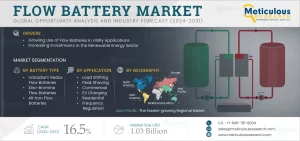The Flow Battery Market is expected to reach $1.03 billion by 2031 at a CAGR of 16.5% during 2024–2031.
Renewable energy sources, including solar, wind, hydro, and geothermal power, are increasingly recognized for their vital role in generating electricity with minimal to zero greenhouse gas emissions. This shift not only helps reduce air pollution but also plays a significant part in mitigating climate change, thereby protecting both the environment and public health. By harnessing renewable energy, nations can diversify their energy mix, which diminishes their reliance on fossil fuels and foreign energy sources. This diversification enhances energy security, making countries less vulnerable to supply disruptions and price volatility. In this landscape, flow batteries emerge as a crucial technology, perfectly aligned with the growing emphasis on renewable energy applications.

Download Sample Report Here @ https://www.meticulousresearch.com/download-sample-report/cp_id=5419
The Growing Importance of Renewable Energy
According to the 2023 Global Landscape of Renewable Energy Finance report, global investments in energy transition technologies, which include renewable energy and energy efficiency, reached an impressive USD 1.3 trillion in 2022. This figure marks a record high, reflecting a 19% increase from 2021 levels and a remarkable 70% surge compared to pre-pandemic investment levels in 2019. As of 2022, renewable energy sources accounted for approximately 13.1% of total primary energy consumption in the United States, contributing to 21.5% of total utility-scale electricity generation.
The increase in investments in renewable energy has the potential to drive economies of scale in manufacturing and installation processes. Furthermore, significant investments attract new players and companies into the renewable energy sector, fostering competition, stimulating innovation, reducing costs, and creating job opportunities, all of which contribute to economic growth.
Supporting Policies and Initiatives
Governments around the world are implementing supportive policies to encourage investments in renewable energy projects. These initiatives include subsidies, tax incentives, reduced customs duties, and pricing incentives. For instance, in April 2023, the Government of Austria launched a subsidy scheme aimed at supporting the installation of residential batteries. The Ministry of Climate Action and Energy has allocated a total of USD 16.1 million (EUR 15 million) to assist in the installation of new storage systems and the expansion of existing ones in conjunction with renewable energy projects.
In October 2022, the Government of China announced ambitious plans to enhance the country’s energy storage capacity by 2030, in line with its goal of achieving net-zero emissions by 2060. The China Energy Storage Alliance reported that the Chinese government aims to increase the country’s battery storage systems by over 100 GW and pumped hydro capacity by an additional 100 GW.
Similarly, in July 2022, Public Sector Undertakings (PSUs) under the Government of India made significant investments in energy storage technologies, including solar photovoltaic (PV) projects. The Solar Energy Corporation of India (SECI), a Central Public Sector Enterprise (CPSE) under the Ministry of New and Renewable Energy, has undertaken three notable projects:
- A 1.4 MW Solar PV Project featuring a 1.4 MWh Battery Energy Storage System in Kavaratti Island, UT of Lakshadweep (supported through a MNRE grant).
- A 50 MWp SPV Project with a 20 MW/50 MWh BESS at Phyang, Leh, UT of Ladakh (backed by a Government of India grant under PMDP 2015).
- A 100 MW SPV Project with a 40 MW/120 MWh BESS at Rajnandgaon, State of Chhattisgarh.
These investments and initiatives highlight the global commitment to advancing renewable energy sources and the necessary technologies to support them.
Get Insightful Data On Regions, Market Segments, Customer Landscape, And Top Companies (Charts, Tables, Figures And More) :- https://www.meticulousresearch.com/request-sample-report/cp_id=5419
Flow Batteries: The Key to Energy Storage
As the demand for renewable energy grows, so does the need for effective energy storage solutions. Flow batteries are emerging as a leading technology in this arena, offering substantial storage capacities, grid stability support, and extended cycle lives. They are uniquely suited for renewable energy applications, helping to address the intermittent nature of sources like solar and wind.
Flow batteries operate on a simple yet efficient principle: they store energy in two separate liquid electrolyte solutions. This design allows for scalable energy storage capacity, as the size of the tanks can be increased without affecting the battery’s power output. This scalability makes flow batteries ideal for large-scale renewable energy projects.
Benefits of Flow Batteries
- High Storage Capacity: Flow batteries can store large amounts of energy, making them suitable for renewable applications that require substantial energy reserves.
- Long Cycle Life: Unlike traditional batteries, flow batteries can endure thousands of charge and discharge cycles with minimal degradation, leading to longer operational lifespans.
- Rapid Response Time: Flow batteries can quickly respond to fluctuations in energy demand, providing reliable power during peak usage periods.
- Environmental Friendliness: Many flow batteries use non-toxic materials, making them an environmentally friendly option compared to conventional lead-acid or lithium-ion batteries.
Scope of the Report:-
By Offering
- Energy Storage Systems
- Batteries
- Services
By Battery Type
- Vanadium Redox Flow Batteries
- Zinc-Bromine Flow Batteries
- All-Iron Flow Batteries
- Other Flow Batteries
By Material
- Vanadium
- Zinc-Bromine
- Hydrogen-Bromine
- Other Materials
By Ownership
- Utility-owned
- Third-party-owned
- Customer-owned
By Application
- Load Shifting
- Peak Shaving
- Commercial
- Transmission & Distribution
- EV Charging
- Residential
- Frequency Regulation
- Other Applications
By End User
- Utilities
- Commercial & Industrial
- Off-grid & Micro-grid Power
- EV Charging Station
- Residential
- Other End Users
Immediate Delivery Available | BUY THIS RESEARCH REPORT (Insights, Charts, Tables, Figures and More) – https://www.meticulousresearch.com/Checkout/56379972
Market Growth and Future Outlook
The growing investment in renewable energy sources is significantly driving the demand for energy storage solutions, particularly those powered by flow batteries. These systems play a crucial role in storing surplus energy generated during peak production periods and offering a reliable power source during low production times or high demand scenarios.
Recent projections indicate that the global flow battery market is set for substantial growth. The increasing adoption of electric vehicles (EVs), advancements in renewable energy technologies, and supportive government policies are all contributing to this upward trend.
As countries worldwide strive for sustainability, the adoption of flow batteries is expected to accelerate. The renewable energy sector is anticipated to benefit from technological advancements that improve the efficiency and cost-effectiveness of flow batteries, further enhancing their appeal.
Contact Us:
Meticulous Market Research Pvt. Ltd.
1267 Willis St, Ste 200 Redding,California, 96001, U.S.
USA: +1-646-781-8004
Europe: +44-203-868-8738
APAC: +91 744-7780008
Email– sales@meticulousresearch.com
Visit Our Website: https://www.meticulousresearch.com/
Connect with us on LinkedIn- https://www.linkedin.com/company/meticulous-research
Meticulousblog.org | Top Market Research Reports Blog – https://meticulousblog.org/






